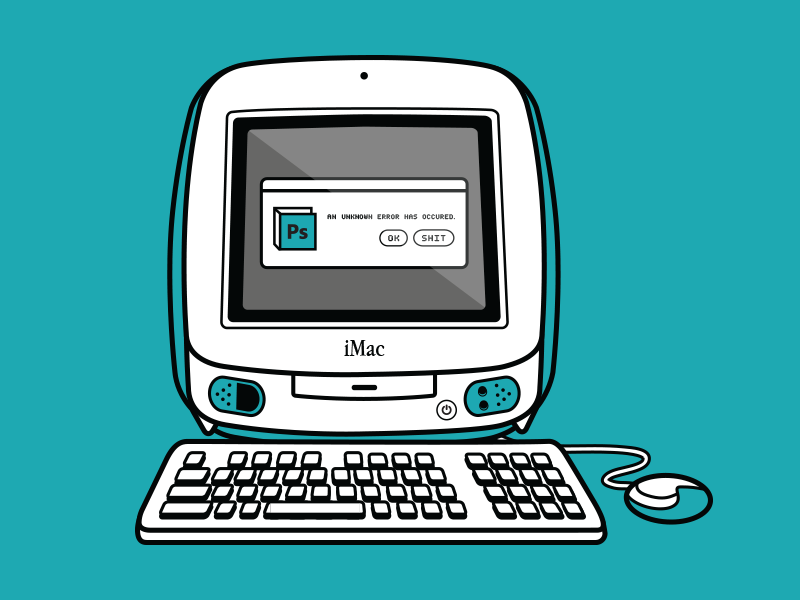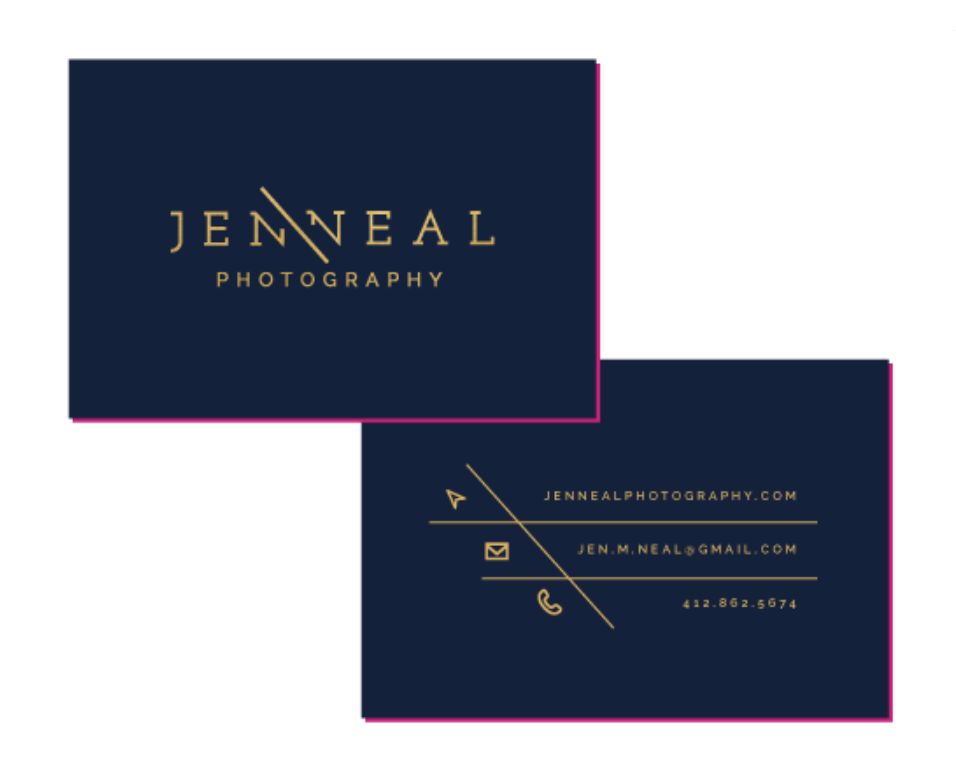Class critiques always went something like this for me:
I would stumble into class right on time, coffee in hand and bleary-eyed from a late night of making tweaks to a design project. I’d pin my draft to the critique board, look around at the concepts everyone else had come up with, and feel pretty good about what I created.
But then Kyle would stroll in 15 minutes late, fresh as a daisy. He would pull his concept out of his bag and nonchalantly pin it to the board as I held my breath and sank a little lower in my seat.
His concept and execution was perfect. He nailed it - yet again - and put us all to shame, receiving raving reviews from our professor while the rest of us got “constructive criticism.”
And I couldn’t help but take notice.
I wanted the positive affirmation from my professors. I wanted everyone else in my class to look at my work the same way they looked at Kyle’s. I wanted to stand apart and get noticed.
So I tried to mimic his style.
Now I should mention that Kyle’s style couldn’t have been further from the bright, colorful, feminine aesthetic you may have seen in my current portfolio and around this site. Instead, it was edgy, hipster, and bold.
And as you can imagine, I failed miserably.
I received terrible feedback from my professors. My classmates didn’t take me seriously because they didn’t see any original ideas. And the worst part? I felt like a fraud. The results of copying Kyle were the exact opposite of what I was striving for.
But even if I had succeeded in mimicking Kyle’s aesthetic and did receive positive feedback, I still wouldn’t have won. It wasn’t my style or creativity. It would’ve still been Kyle’s victory, not mine.
Eventually I gave up copying and decided to go full-force in my own direction. Somewhere along the line I learned to embrace my colorful, feminine aesthetic and played up what I knew.
As a result, I started to gain great feedback and stand apart from my peers.
I’ve found the same to be true in business.
When new creatives enter into saturated industries like design and photography, inspiration isn’t difficult to find. In fact, it’s everywhere.
Pinterest and Instagram make it easy for us to follow along with our peers and see what they’re creating, which often leaves us playing a comparison game and measuring our work against theirs.
And that’s when doubt can start to creep in and take root.
When you’re insecure in your own abilities, it’s far too tempting to look at what established, successful creatives are doing and try to mimic their approach and aesthetic.
But those who follow never get ahead or stand apart.
Just like my experience in college, you’ll end up achieving the opposite of what you’re striving for.
Your peers won’t take you seriously. Your work will suffer. You’ll be frustrated with yourself. And you’ll always be paranoid about other people finding you out.
The hard truth about creative entrepreneurship
Here’s some hard truth, guys:
You aren’t a creative entrepreneur if you’re constantly looking to others for inspiration.
Creative - relating to or involving the imagination or original ideas, especially in the production of artistic work; having good imagination or original ideas
Entrepreneur - a person who starts a business and is willing to risk loss in order to make money; one who organizes, manages, and assumes the risks of a business or enterprise
The words “creative” and “entrepreneur” in and of themselves set an expectation of coming up with new ideas and taking risks; not copying what’s already been done before.
This quote from Steve Tobak hits the nail on the head.
“Nobody ever changed the world by doing what everyone else is doing… Leaders lead. Followers follow. You can’t be both.”
You can’t call yourself a creative entrepreneur if you aren’t willing to step out on your own and highlight your own creativity.
And you’re never going to stand out if you’re stuck in your comfort zone.
I’m not just speaking to those of you who have just started your business; this is true for the entire lifespan of your business.
During Elle & Company’s first year I remember telling my husband, Jake, that I couldn’t wait until things leveled out and I didn’t have to keep coming up with new ideas for my business. He looked surprised and confronted me with a sobering truth:
The day your business becomes “comfortable” is the day your business dies.
It’s like a basketball game. As long as you’re in business, the clock is running. If you have a comfortable lead and decide to cash it in for the rest of game, your lead will dwindle and you’ll lose the game.
If you look around at industry leaders, they don’t sit down in the middle of the court while everyone else plays the game. They never get comfortable. They’re constantly taking risks and coming up with new ideas to keep their lead.
(Oh, and by the way - those who stay in their comfort zone are on the bench. They may be wearing the uniform, but they’re not even in the game.)
As long as the clock is running, you have to be playing the game.
However, this is exciting news for us creative types because we tend to get bored with the normal. We want to be creating. The thought of new ideas and new challenges should excite us.
So instead of getting discouraged or overwhelmed by the thought of consistently coming up with new ideas and taking risks, think of it as a fun creative challenge.
You might fail from time to time and it might take a while to find something that sticks, but don’t let that keep you on the bench. And definitely don’t let it tempt you to copy what others in your industry are doing.
If you want your business and your work to stand out, you have to be willing to break the mold, take the lead, and differentiate it.
But you can’t differentiate your business if you’re mimicking the way others are running theirs. So stop looking to everyone else and check out these 4 sure-fire ways to differentiate your business, instead.
4 Simple Ways to Differentiate Your Business
The questions in each of these 4 categories are set up as an exercise. While you don’t have to work through each and every one, take a handful into consideration and put your own creative spin on them.
1 | Differentiate your offerings
How do your products and services set you apart?
- Is there something you could be offering that could help you distinguish your business from others in your industry?
What materials do you use to produce your product/service?
- Do you use Squarespace instead of Wordpress? Film instead of digital? Organic ingredients instead of non-organic?
Where do your profits go?
- Does a portion of it go to preventing human trafficking or clothing kids in third-world countries?
How many products/service packages do you offer?
- Are you unique because you offer several products or are you unique because you only offer one?
How broad is your offering?
- You may need to specialize and narrow your scope to differentiate your business.
How customizable are your packages or offerings?
- Are you flexible or do you provide everything for your clients/customers so they don’t have to worry about a thing?
And most noticeably, what unique products/services can you offer that aren’t being offered already?
- Is there a need among your audience that isn’t being met by anyone else in your industry?
2 | Differentiate your process
What is your time frame?
- Are your offerings one-of-a-kind because you turn them around quickly or because you take your time?
How much client involvement do you allow?
- Do you invite your clients in on every step of the process or do you surprise them with the outcome?
What does your client experience look like?
- Do you surprise clients with gifts and extras? Do you go above and beyond to give them special treatment?
3 | Differentiate your marketing strategies
How are you using your blog to set your business apart?
- Could utilizing it differently than others in your industry help differentiate your business?
How are you using your mailing list to set your business apart?
- What could you offer your audience that provides value and differentiate your business?
How are you using social media to set your business apart?
- Is your approach to Instagram, Twitter, or Pinterest unique?
How are you using other outlets like webinars to set your business apart?
- Are there any outlets that your industry hasn’t caught onto yet?
Does the type of content you share set you apart?
- Does the quality or quantity of your content differentiate your business?
4 | Differentiate your brand
How are your visuals different from others in your industry?
- Photos, graphics, color palette, fonts, illustrations, patterns, blog graphics…
How is your tone different from others in your industry?
- Which terminology and phrases do you frequently use? What do you name your products and service packages?
Don’t underestimate your own creativity. Not only are you fully capable of differentiating your business and standing apart from others in your industry, but your wins will be a thousand times more gratifying when they’re a result of your own original ideas.
What makes your business stand apart? Which of the questions above were helpful for you?



















